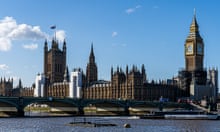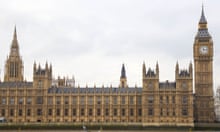In my dotage I don’t go to the ancient Palace of Westminster as often as I did when I was covering British politics full-time. But nor does anyone else who works there.
The rhythm of the place has changed profoundly. So Nick Watt’s report that MPs and peers may be decanted for six years to permit a relatively speedy overhaul ought to be the cue for a rethink of functions. I am about to have a lightbulb moment. Literally.
As Watt reminds readers, the planners are toiling to reconcile urgent repairs, budgetary constraints and a Unesco world heritage site with the requirements of a busy legislature. They have concluded that moving MPs to a temporary structure on the edge of what is known as the parliamentary estate, and peers to one in the round Treasury courtyard (seen briefly in Spectre, the latest James Bond film) would be the cheapest, fastest option.
As Watt points out, it’s happened before. That thrusting young moderniser Henry VIII finally moved the royal household across the road to Whitehall after a nasty fire in 1512, leaving the place to politicians and lawyers. The great fire of 1834 consumed more antiquity – 11th century Westminster Hall is the great survivor – and led to Charles Barry’s neo-Gothic masterpiece, now falling apart. Second world war bombs destroyed the Commons chamber. It’s all here.
Gothic goes in and out of fashion. Some people dislike the building; others what it stands for. “Westminster politics” as a glib term of abuse is not confined to Scotland, whose own ambitious but cosy new parliament building at Holyrood will also go out of fashion in due course. Politically as well as architecturally. It’s what happens.
But no one seriously envisages pulling down the iconic Victorian building and putting up affordable housing, or selling the site to Google at a knockdown price. So what to do? The palace authorities, less amateur than they once were, have been patching it up during the summer recess for decades. Floorboards up, scaffolding and dust sheets, miles of exposed cable, it resembles a liner undergoing a refit every summer. But a succession of reports, here for instance , and most decisively last June, confirm that patchwork repairs are no longer enough. That way it could take 32 years! When we say leaks we don’t always mean political ones. Me, I once killed a mouse on a colleague’s desk with a stapler.
Great efforts have been made, especially under John Bercow’s speakership (he has his good points), to open the building up to the voting public. It’s always full of school parties. Good. Paradoxically, security has got ever tighter since the IRA tried to bomb it and Osama bin Laden got his franchise up and running. The old token searches for Guy Fawkes II – sniffer dogs before daily prayers – have long since become very real. Armed police are now a familiar sight.
So it is security that dictates how temporary chambers for the nation’s elected representatives (and the unelected ones) would have to be built on secure adjoining sites, Nick Watt explains, close to Portcullis House and the Norman Shaw buildings (once New Scotland Yard) where most MPs offices are: these bits don’t need modernising.
But that throws up one of the great changes of recent years. When Portcullis opened in 2001 (its tall chimneys are meant to complement the Queen Anne style of Norman Shaw next door) its bright new offices and TV-friendly committee rooms immediately shifted the palace’s centre of gravity. It moved from gloomy Victorian Gothic and Augustus Pugin’s magnificently lurid wallpaper, to sunny 21st century atrium light and modern coffee options.
It’s now the heart of the building with the old committee rooms, not equipped for live TV (the wallpaper and carpets don’t look right on TV either), that is often empty. Except at the Lords end – the far end from Big Ben – or behind closed doors where parliamentary staff work and some MPs still have their offices, it’s like a deserted village.
The fact that the live TV feed allows them to keep an eye on what’s happening in the chamber while they get on with the avalanche of constituency mail and email (which grows exponentially), accentuates the trend to treadmill isolation for many backbenchers. So do “family friendly” hours and “reform” of procedure that restrict individual MPs’ scope for making trouble.
A 9 to 5 regime undoubtedly makes the work/life balance easier, especially for women MPs, and committees are more powerful now. Good again. But there’s been a loss of collective ethos, of cross-party collegiality, which sometimes matters when MPs are required to stand up to the collective power of government. Bercow is a force for good in this context, forcing more ministers to account for themselves at the dispatch box when they don’t want to. But by 8pm the building often has a deserted air, so different from even 20 years ago.
The Commons chamber can be as busy as ever, though less often than in the era of major set piece debates between the big beasts. But votes are often rescheduled to be taken at more “convenient” times. Visitors can sometimes see MPs traipsing across from Portcullis en masse, to vote. They use the Victorian underpass and look like forest animals on a well-trodden path. But the old holy of holy, the Members’ Lobby, where reporters like me used to hang out in search of gossip (hence the name, lobby correspondent), is all but empty, no longer the MPs’ crossroads that it was.
It ought to be possible to rehabilitate the miles of gloomy corridor and old-fashioned committee rooms for modern purpose. The trouble is that Pugin’s famous designs – he was brought in by Barry, whose architectural background was in the classical tradition – are integral to the building’s genius, the details still stunning. It’s just not the sort of place where you could knock through walls to do open plan.
But we can’t just spend billions to restore the palace as a museum. Much of it, the Lords chamber for example, is ravishingly beautiful in an OTT way. We talk a lot about openness and inclusivity in the tech era which offers so much scope. Gothic rooms are used more than ever for semi-public meetings. Jeremy Corbyn was exactly the sort of MP who staged “Ban the Whatever” sessions for activists there in a previous life.
Last year a new education centre was opened in new premises at the Lords end. Surely we can do more in that direction, using revamped but underused parts of the parliamentary estate? Yes, there’s a security problem, but it’s handled with ever greater dexterity now. Nothing can ever be totally safe.
It would also be good to steer more official activity back to the old palace, away from Portcullis which has become Berlin to the Gothic end’s Bonn: a magnet drawing energy in its own direction. My own lightbulb moment is just that: better lighting. It’s currently far too yellow and old fashioned in an age of sharp white light.
Then again, those long corridors are lined with dark varnished wood and brightly patterned carpets, probably meant to be Pugin-esque but lacking his flair. Strip off all that dark varnish? Replace the carpets with something calmer? Improve the lighting? Pugin’s wallpapers and all those VIP paintings might look even better in a fresher setting.
Trivial perhaps, compared with structural repairs and the obsession with asbestos. And what do I know? Actually I do know that the palace gave the rabbit warren of rooms known as the press gallery a makeover a few years back. The hacks liked our old squalor and I will never forgive the destruction of the old bar, but they were adamant: asbestos, roof problems and ’elf and safety.
It’s all lighter and brighter now, the Guardian’s grim office even got a couple of new windows with real daylight. Brilliant! So it can be done while respecting the Gothic heritage. Indeed the Central Lobby, where voters come to lobby their MPs, was built to be flooded with natural light, uniquely so in the gloom, and is as lovely as it was on day one.
Great designer that he was, Pugin would see new possibilities now available. Let there be light!










Comments (…)
Sign in or create your Guardian account to join the discussion